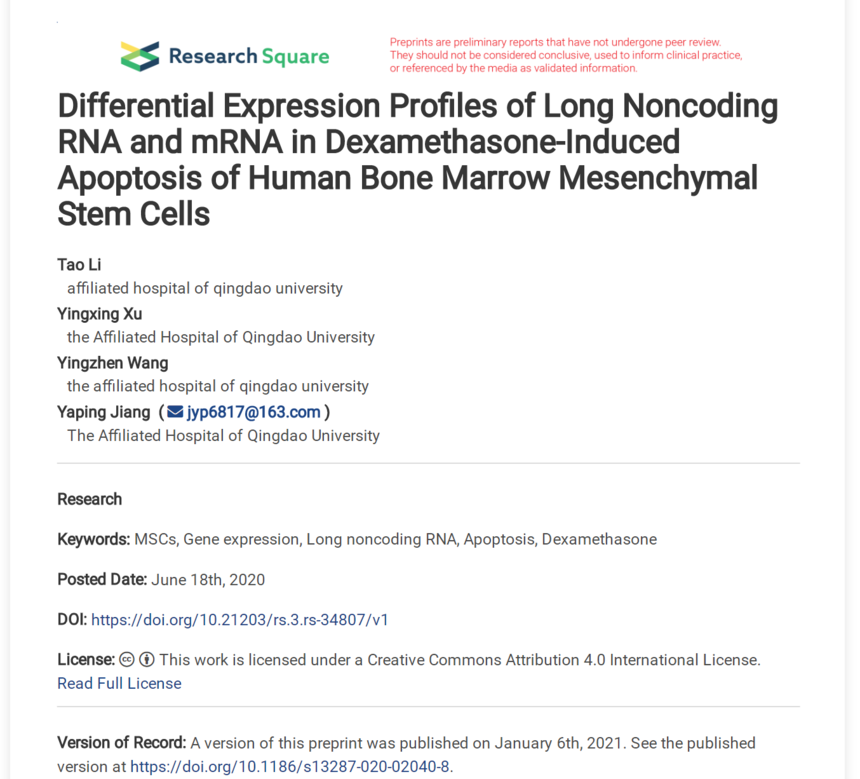|
|
Li, T.,Differential expression profiles of long noncoding RNAs and mRNAs in human bone marrow mesenchymal stem cells after exposure to a high dosage of dexamethasone. Stem Cell Res Ther 12, 9 (2021).Li, T., Xu, Y., Wang, Y. et al. Differential expression profiles of long noncoding RNAs and mRNAs in human bone marrow mesenchymal stem cells after exposure to a high dosage of dexamethasone. Stem Cell Res Ther 12, 9 (2021). https://doi.org/10.1186/s13287-020-02040-8 原文:https://www.researchsquare.com/article/rs-34807/v1 AbstractBackgroundAbnormalities in apoptosis, cell cycle, proliferation, and differentiation of human bone marrow mesenchymal stem cells (hBMSCs) significantly impact bone metabolism and remodeling, resulting in various skeletal disorders. Long-term exposure to a high dosage of dexamethasone (Dex) induces apoptosis and inhibits the proliferation of mesenchymal stromal cells (MSCs), which are probable primary causes of various skeletal disorders. However, to date, the exact mechanisms of action of Dex on hBMSCs have not been fully elucidated. MethodsTo explore the effects of Dex on apoptosis, cell cycle, proliferation, senescence, osteogenic and adipogenic differentiation of hBMSCs at the various exposure times and concentrations, Hoechst 33342/PI staining, flow cytometry, crystal violet assay, β-galactosidase (β-GAL) activity assay, alizarin red S (ARS) staining assay, and Oil Red O (ORO) staining assay were performed. A microarray assay was used to identify differentially expressed lncRNAs and mRNAs in 10− 6 mol/L Dex-treated hBMSCs, and a bioinformatics analysis was conducted to further explore the role of these differentially expressed lncRNAs and mRNAs in the coding and noncoding (CNC) network. Furthermore, the microarray results were validated using quantitative real-time PCR (qRT-PCR) analysis. ResultsOver the range of 10−8, 10−7, and 10−6 mol/L, Dex induced apoptosis, arrest of the cell cycle, inhibition of osteogenic differentiation, and promotion adipogenic differentiation of the hBMSCs in a dose-dependent manner. In addition, 10−6 mol/L Dex significantly induced apoptosis, suppressed proliferation, and increased the senescence of hBMSCs in a time-dependent manner. Interestingly, this time-dependent effect of Dex on the apoptosis of hBMSCs plateaued at the 7th day and decreased from the 8th day to the 10th day, while Dex treatment increased senescence of the hBMSCs on the 6th day. Furthermore, the microarray analysis identified a total of 137 differentially expressed mRNAs (90 upregulated and 47 downregulated) and 90 differentially expressed lncRNAs (61 upregulated and 29 downregulated) in hBMSCs after exposure to 10−6 mol/L Dex. The differentially expressed mRNAs and lncRNAs were associated with the regulation of cell apoptosis, proliferation, and cell cycle. Meanwhile, several signaling pathways involved in these processes, including the mTOR signaling pathway, Ras signaling pathway, HIF-1 signaling pathway, NF-kappa B signaling pathway, and TGF-beta signaling pathway, also were identified through the interaction net in the significant pathways (Path-Net) analysis. Furthermore, the CNC network further identified 78 core regulatory genes involved in the regulation of apoptosis. Additionally, qRT-PCR was used to confirm the identity of the key differentially expressed mRNAs and lncRNAs found to be closely associated with cell apoptosis to confirm the reliability of the microarray dataset. ConclusionsIn summary, the effect of Dex on apoptosis, cell cycle, proliferation, and osteogenic differentiation and adipogenic differentiation of the hBMSCs depended on exposure time and concentration. Continuous exposure to 10−6 mol/L of Dex for 7 days may be a suitable protocol for inducing the apoptosis of hBMSCs. Under this protocol, differentially expressed lncRNAs and mRNAs associated with apoptosis, cell cycle, and proliferation were identified, providing a new research direction for further studies.
|




